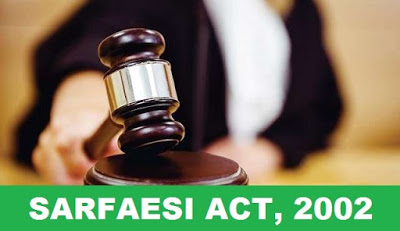The Securitisation and Reconstruction of Financial Assets and Enforcement of Securities Interest Act, 2002 (also known as the SARFAESI Act) is an Indian law. It allows banks and other financial institution to auction residential or commercial properties (of Defaulter) to recover loans. The first asset reconstruction company (ARC) of India, ARCIL, was set up under this act.
- The SARFAESI Act was passed on December 17, 2002, in order to lay down processes to help Indian lenders recover their dues quickly.
- The SARFAESI Act essentially empowers banks and other financial institutions to directly auction residential or commercial properties that have been pledged with them to recover loans from borrowers.
- Before this Act took effect, financial institutions had to take recourse to civil suits in the courts to recover their dues, which is a lengthy and time-consuming process.
- As per the SARFAESI Act, if a borrower defaults on a loan financed by a bank against collateral, then the bank gets sweeping powers to recover its dues from the borrower.
- After giving a notice period of 60 days, the lender can take possession of the pledged assets of the borrower, take over the management of such assets, appoint any person to manage them or ask debtors of the borrower to pay their dues too, with respect to the asset.
- This recovery procedure saves banks and financial institutions a lot of time which otherwise would be long drawn out due to the intervention of courts.
- One of the major drawbacks of the Act is that it is not applicable to unsecured creditors.
- ARCs or Asset Reconstruction Companies which buy out distressed assets are the other alternatives that banks use to offload doubtful debt, to ensure more focussed and efficient resolution, say experts.
- The Co-operative banks initially were not covered under the definition of banks for which the SARFAESI Act was applicable.
- In 2003, a notification was issued (without amending the law) to bring co-operative banks within the class of banks entitled to use SARFAESI.
- In 2013, the government amended the Act to include co-operative banks formally under the definition of banks eligible to use it.
- However, petitions were filed questioning the authority of the notification and the power of Parliament to amend the SARFAESI Act.
- On May 5, 2020, the Supreme Court resolved this by ruling in favour of co-operative banks invoking the SARFAESI Act.
- This move helps co-operative banks avoid inordinate delays in the recovery of their bad loans due to the involvement of civil courts and co-operative tribunals.
- In Mardia Chemicals Ltd. v. ICICI Bank, on 8 April 2004, the Supreme Court of India declared the Sarfaesi Act to be constitutionally valid. The Court said that a borrower may appeal against the lender in the debt recovery tribunal, without having to deposit 75% of the amount of the debt. If the tribunal does not stay the order, the lender may sell the assets.
- The Indian banking system has 1,544 urban co-operative banks (UCBs) and 96,248 rural co-operative banks, with substantial deposits from retail investors.
- For the smooth functioning of these co-operative banks, speedy recovery of defaulting loans is critical.
- If you are a borrower defaulting on the loan taken against collateral, be warned that if you do not fulfil your liabilities in the 60-day notice period, the bank has the powers to recover the debt by selling off the collateral.
By-
Jyotirmoy Banerjee
JNU Jaipur, BBA.LLB (Hons)

